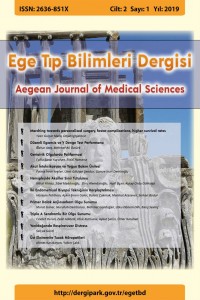Abstract
ABSTRACT
Objective:
Brachial plexus and peripheric nerves of the upper extremities can be damaged
in hemiplegic shoulder subluxation. This study aimed to determine the
relationship between shoulder subluxation and axillary nerve injury.
Methods:
Sixty patients with stroke were included in the study. The Brunnstrom
Scale and the Ashworth Scale were used
to evaluate the motor and muscle tone,
respectively. Functional evaluation was performed with the Fugl–Meyer Scale and
the Stroke Impairment Assessment Set . The Van Langenberghe method was used to
grade shoulder subluxation on anterior-posterior shoulder X-ray. Latencies and
amplitudes of the axillary nerves of the normal and hemiplegic sides were
compared using electromyographs.
Results:
The latency of the axillary nerves of the hemiplegic sides (4.,2±0.,75 msn) was prolonged when compared to that of
the normal sides (3.,7±0.,7 msn), and this difference was statistically
significant (P<0.,001). The amplitudes of the compound muscle action
potential of the hemiplegic sides (4.,1±4.,22 mv) lower than that of the normal sides
(6.,1±6.,57 mv) (P<0.,001).
Conclusions:
Shoulder subluxation may cause injury not only to the axillary nerve but also to other peripheric
nerves and the brachial plexus. Detecting shoulder subluxation and additional axillary nerve injury could in
help planning an appropriate rehabilitation program and contribute to
functional recovery by preventing complications.
References
- REFERENCES
- REFERANCE 1. Stein J, Harvey RL, Macko RF, Winstein CJ, Zorowitz RD. Stroke recovery and rehabilitation: Çeviri: Arasıl T, Öztürk EA. İnme İyileşmesi ve Rehabilitasyonu. 1st Edd. Pelikan Yayıncılık. Ankara. 2012: p.31-44.
- REFERANCE 2. Uzunca K. Iİnmede Üst Ekstremite Komplikasyonlari ı. Türk Fiz Tıp Rehab Derg 2006; 52(ÖzelEk B) 2003;6:39-45.
- REFERANCE 3. Aras M, Çakıcı A. İnme Rehabilitasyonu. 2nd Edd. Oğuz H, Dursun E, Dursun N. Nobel matbaacılık. İstanbul. 2004. p.589-626.
- REFERANCE 4. Basmajian JV. Muscles Alive: their functions revealed by electromyography. Baltimore, Md: Williams & Wilkins; 1978.
- REFERANCE 5. Chino N. Electrophysiological investigation on shoulder subluxation in hemiplegics. Scand J Rehab med 1981; 13: 17-21.
- REFERANCE 6. Griffin JW. Hemiplegic shoulder pain. Phys Ther. 1986; 66:1884-93.
- REFERANCE 7. Tsur A, Ring H. Axillary nerve conduction changes in hemiplegia. Journal of Brachial Plexus and Peripheral Nerve Injury 2008; 2: 26.
- REFERANCE 8. Chaco J, Wolf E. Subluxation of the glenohumeral joint in hemiplegia. Am J Phys Med. 1971; 50:139-43.
- REFERANCE 9. Van Ouwenaller C, Laplace PM, Chantraine A. Painful shoulder in hemiplegia. Arch Phys Med Rehabil. 1986; 67:23-6.
- REFERANCE 10. Ikai T, Tei K, Yoshida K, Miyano S, Yonemoto K. Evaluation and treatment of shoulder subluxation in hemiplegia: relationship between subluxation and pain. Am J Phys Med Rehabil. 1998; 77: 421-426.
- REFERANCE 11. Paci M, Nannetti L, Rinaldi LA. Glenohumeral subluxation in hemiplegia. Physiother Res Int. 2007; 12: 95-104.
- REFERANCE 12. Van Langenberghe HV, Hogan BM. Degree of pain and grade of subluxation in the painful hemiplegic shoulder. Scand J Rehabil Med. 1988; 20 : 161-166.REFERANCE 13. Duncan PW, Propst M,Nelson SG. Reliability of the Fugl-Mayer Assessment of Sensorimotor Recovery Following Cerebrovasküler Accident.
- REFERANCE 14. Rabadi MH, Rabadi FM. Comparison of the action research arm test and the Fugl Mayer assessment as measures of upper-extremity motor weakness after stroke. Arh Phys Med Rehab. 2006; 87: 962-966.
- REFERANCE 15. Chıno N,Sonoda S,Domen K,Saitoh E,Kimura A. Stroke Impairment Assessment Set (SIAS). A new evaluation instrument for stroke patients. Jpn J Rehabil Med 1994; 31: 119-125.
- REFERANCE 16. Gregson J, Leathley M, Moore A et al. Reliability of tone assessment scale and the modified Ashworth scale as clinical tools for assessing post stroke spasticity. Arch Phys Med Rehab il 1999; 80: 1013-1016.
- REFERANCE 17. Shin j.OH, Clinical Electromyography : nerve conduction studies 3rd edition 2003; p191
- REFERANCE 18. Walsh MT. Upper limb neural tension testing and mobilization. Fact, fiction, and a practical approach. J Hand Ther. 2005 Apr-Jun;18:241-58.
- REFERANCE19. Ring H, Tsur A, Vashdi Y: long term clinical and elektromyographical (EMG) follow up of hemiplegic’s shoulder. Eur J Phys Med Rehabil 1993;3:137-140.REFERANCE 20. Kallio MA, Kovala TT, Niemelä ENK, Huuskonen UEJ, Tolonen EU. Shoulder pain and an isolated teres minor nerve lesion. J Clin Neurophysiol. 2011 oct; 28:524–7.
- REFERANCE 21. Emam F, Genedy AFM, Mahmoud SA: Axillary nerve conduction study in paretic limbs of patients with cerebrovasküler stroke. The Egyption Journal of Hospital Medicine 2014 January 54; 94-100.
- REFERANCE 22. Taksande B, Ambade M, Josh R: Delayed axillary nerve motor conduction latency and reduced CMAP amplitudes in the paretic limbs of patients with a cerebrovasküler episode. Journal of Nörology Research 2011 oct; 1: 210-214.
- REFERANCE 23. Paci M, Nannetti L, Rinaldi LA. Glenohumeral subluxation in hemiplegia. Physiother Res Int. 2007 Jun;12:95-104.
Details
| Primary Language | English |
|---|---|
| Subjects | Clinical Sciences |
| Journal Section | Original Investigation |
| Authors | |
| Publication Date | April 1, 2019 |
| Acceptance Date | January 18, 2019 |
| Published in Issue | Year 2019 Volume: 2 Issue: 1 |
The articles published in this journal are licensed under Creative Commons Attribution-NonCommercial 4.0 International License (CC BY-NC 4.0).

